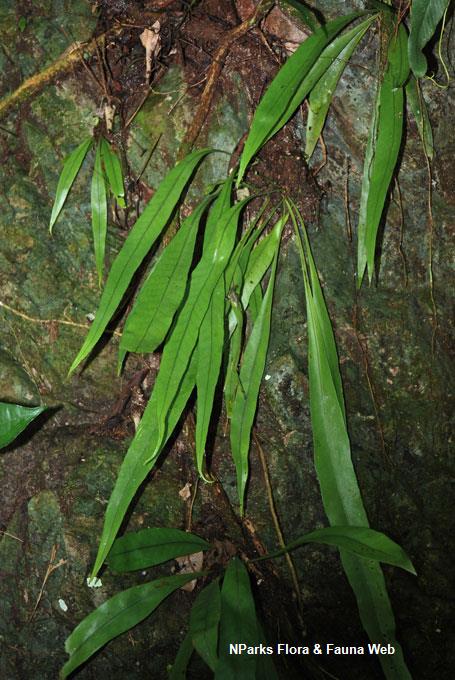
Back
Microsorum musifolium (Blume) Copel. 'Crocodyllus'
| Family Name: | Polypodiaceae |
| Synonyms: | Polypodium musifolium 'Crocodyllus' |
| Common Name: | Crocodile Fern, Alligator Fern, Crocodyllus Fern |
Name
Classifications and Characteristics
| Plant Division | Ferns & Lycophytes (Non-Seed Vascular Plants) (Fern) |
|---|---|
| Plant Growth Form | Epiphyte |
| Lifespan (in Singapore) | Perennial |
| Mode of Nutrition | Autotrophic |
| Plant Shape | Shrubby |
| Maximum Height | 0.3 m to 1 m |
| Maximum Plant Spread / Crown Width | 0.6 m to 1.2 m |
Biogeography
| Preferred Climate Zone | Tropical |
|---|---|
| Local Conservation Status | Non-native (Horticultural / Cultivated Only) |
Description and Ethnobotany
| Growth Form | Epiphytic fern, relatively large, up to 1 m tall by 1.2 m wide, with rosette-like foliage arrangement that acts to collect fallen detritus. Dark brown, creeping horizontally just below substrate surface, with short internodes (1 - 2cm), and fronds arising from multiple nodes. |
|---|---|
| Foliage | Fronds light green, strap-shaped, 55 - 65 cm long by 8 - 14 cm wide, fairly thick and waxy with undulating margins, abaxially-protruding midrib and prominently-netted dark green venation, which becomes more conspicuous as plant ages. Conxex bulges in between primary and secondary veins result in fronds' dimpled reptilian appearance. Fertile and sterile fronds similar in form. |
| Reproductive Parts - non-flowering plant | Spore cases round, numerous and densely scattered all across underside of frond in between veins, maturing from cream to brownish. |
| Similar | Patented cultivar, originally derived from a naturally-occurring whole-plant mutation of a selection of Microsorum musifolium belonging to a private grower in Kuranda, Australia. Differentiated from the parent species by its bushier habit, smaller but more numerous fronds, smaller rhizomes and more rapid growth. |
| Cultivation | One of the more hardy, easy-to-grown ferns. Prefers bright shade, exposure to more light promotes a more upright growth habit with shorter stiffer fronds. Likes good air circulation and high humidity, container-grown plants can be placed on top of a water-filled pebble tray, or over pond or water feature. Requires moist but porous and well-drained substrates, suitable potting mixes include coarse peatmoss, sphagnum moss, pine bark, cocopeat, compost and coarse sand. If grown indoors where plant cannot collect detritus, feed with weak fertilizer every other week. |
| Etymology | Genus epithet 'Microsorum' means 'small sori', describing the spore cases on the underside of fronds. Species epithet 'musifolium' means 'banana-like leaves', a reference to the fern's elongated strap-like fronds. Note:- Genus epithet sometimes misspelt as Microsorium - an orthographic variant of the originally-published (1833) and accepted 'Microsorum'; the variant came about after botanist and name-originator Link inadvertently used both spellings in his subsequent 1841 publication. |
| Ethnobotanical Uses | Others: Freshly-cut fronds used as an attractive accent in floral arrangements. |
Landscaping Features
| Desirable Plant Features | Ornamental Foliage |
|---|---|
| Landscape Uses | Interiorscape/ Indoor Plant, General, Focal Plant, Container Planting, Parks & Gardens, Small Gardens |
Fauna, Pollination and Dispersal
| Seed or Spore Dispersal | Abiotic |
|---|
Plant Care and Propagation
| Light Preference | Semi-Shade |
|---|---|
| Water Preference | Moderate Water |
| Plant Growth Rate | Moderate |
| Rootzone Tolerance | Well-Drained Soils |
| Maintenance Requirements | Moderate |
| Propagation Method | Storage Organ, Division, Spore |
Foliar
| Foliage Retention | Evergreen |
|---|---|
| Mature Foliage Colour(s) | Green |
| Mature Foliage Texture(s) | Smooth, Leathery, Raised / Sunken Veins, Thick |
| Foliar Type | Simple / Unifoliate |
| Foliar Shape(s) | Non-Palm Foliage (Lanceolate) |
| Foliar Venation | Pinnate / Net |
| Foliar Margin | Entire - Wavy / Undulate |
Non - Foliar and Storage
| Stem Type & Modification | Acaulescent |
|---|---|
| Root Type | Underground |
| Specialised Storage Organ(s) | Underground (Rhizome) |
Image Repository
Others
| Master ID | 29438 |
|---|---|
| Species ID | 3747 |
| Flora Disclaimer | The information in this website has been compiled from reliable sources, such as reference works on medicinal plants. It is not a substitute for medical advice or treatment and NParks does not purport to provide any medical advice. Readers should always consult his/her physician before using or consuming a plant for medicinal purposes. |

.jpg)

.jpg)




.jpg)


.jpg)